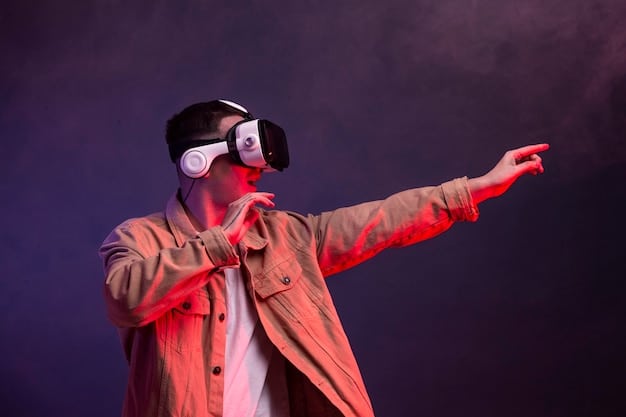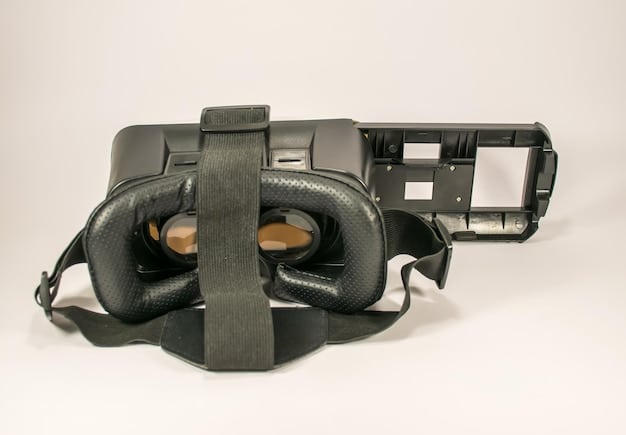The Future of VR Gaming: Latest Innovations & Critical Analysis

The future of VR gaming is rapidly evolving with advancements in hardware and software, offering more immersive and realistic experiences driven by innovations such as higher resolution displays, haptic feedback systems, and sophisticated game engines.
The landscape of virtual reality gaming is constantly shifting, driven by relentless innovation in both hardware and software. This article provides the future of VR gaming: a critical look at the latest hardware and software innovations, dissecting the advancements that are poised to redefine immersive entertainment.
Exploring the evolution of VR headsets
The evolution of VR headsets has been nothing short of revolutionary. From clunky prototypes to sleek, user-friendly devices, the journey reflects significant improvements in display technology, ergonomics, and processing power.
Key milestones in VR headset development
Several milestones mark the evolution of VR headsets. Early models focused on basic immersion, while modern headsets prioritize high resolution, wide field of view, and comfortable design.
- Early prototypes like the Sensorama introduced the concept of immersive experiences.
- The Oculus Rift DK1 and DK2 popularized VR for developers and enthusiasts.
- HTC Vive introduced room-scale VR, allowing for more natural movement.
- Modern headsets from Valve, HP, and Meta offer cutting-edge features like eye tracking and wireless connectivity.
The advancements in display technology have drastically improved visual fidelity. High-resolution screens reduce the screen-door effect, while OLED and LCD panels offer vibrant colors and deep blacks, enhancing the realism of virtual environments.

Ergonomics have also played a crucial role, as manufacturers strive to create headsets that are comfortable to wear for extended periods. Adjustable headbands, balanced weight distribution, and improved ventilation are now standard features, addressing common complaints about early VR headsets.
In conclusion, the evolution of VR headsets demonstrates a commitment to enhancing immersion, comfort, and performance. These advancements pave the way for more captivating and accessible VR gaming experiences.
Advancements in haptic feedback technology
Haptic feedback technology is revolutionizing VR gaming by adding a sense of touch to virtual interactions. These advancements allow players to feel textures, impacts, and environmental effects, creating a more immersive and realistic experience.
Haptic suits and gloves: A new level of immersion
Haptic suits and gloves represent the pinnacle of haptic feedback technology. These devices use a network of sensors and actuators to simulate a wide range of tactile sensations, from the gentle vibration of a raindrop to the forceful impact of a punch.
- Haptic suits provide full-body tactile feedback, allowing players to feel environmental effects and physical interactions.
- Haptic gloves enable precise finger tracking and tactile feedback, enhancing interactions with virtual objects.
- Exoskeleton systems offer force feedback, simulating resistance and weight.
- Wearable devices are becoming more lightweight and affordable, making them accessible to a broader audience.
The integration of haptic feedback enhances gameplay by providing immediate and intuitive feedback. Players can feel the texture of different surfaces, the weight of virtual objects, and the impact of collisions, making the virtual world feel more tangible.
Furthermore, haptic feedback can improve realism in VR training simulations, allowing professionals to practice complex tasks in a safe and controlled environment. Surgeons, engineers, and athletes can benefit from the enhanced realism and feedback provided by haptic technology.

In conclusion, advancements in haptic feedback technology are significantly enhancing the immersion and realism of VR gaming. As these technologies continue to evolve, they promise to create even more captivating and believable virtual experiences.
The impact of 5G and cloud gaming on VR
The advent of 5G and cloud gaming is poised to transform VR gaming by enabling wireless, high-fidelity experiences. These technologies eliminate the need for expensive local hardware, making VR more accessible and convenient.
Unlocking the potential of wireless VR
5G technology offers several advantages for VR gaming. Its high bandwidth and low latency enable wireless streaming of high-resolution VR content, eliminating the need for cumbersome cables.
- 5G networks provide the bandwidth needed to stream high-resolution VR content wirelessly.
- Low latency ensures minimal lag, reducing motion sickness and improving responsiveness.
- Cloud gaming platforms allow users to access VR games without owning powerful local hardware.
- Wireless VR headsets offer greater freedom of movement, enhancing immersion and comfort.
Cloud gaming platforms stream VR games from remote servers, allowing users to access them on a variety of devices. This eliminates the need for expensive gaming PCs or consoles, making VR more affordable and accessible.
Furthermore, cloud gaming enables cross-platform play, allowing users to connect with others regardless of their hardware. This expands the VR gaming community and fosters social interaction.
In conclusion, the combination of 5G and cloud gaming is democratizing VR, making it more accessible and convenient. These technologies promise to unlock the full potential of wireless VR, creating a more immersive and engaging gaming experience.
Artificial intelligence in VR game development
Artificial intelligence (AI) is playing an increasingly important role in VR game development. AI-powered tools and techniques are being used to create more dynamic, realistic, and personalized gaming experiences.
AI-driven characters and environments
AI is used to create non-player characters (NPCs) that behave more realistically and react intelligently to player actions. AI algorithms can simulate human-like behavior, making NPCs more believable and engaging.
- AI algorithms enable NPCs to learn from player interactions, adapting their behavior over time.
- AI-driven procedural content generation (PCG) creates dynamic and diverse game environments.
- AI-powered adaptive difficulty adjusts the game’s challenge based on player skill.
- AI tools assist developers in creating and testing VR games, streamlining the development process.
AI can also be used to generate dynamic game environments that evolve in response to player actions. This creates a more immersive and unpredictable gaming experience, as players never know what to expect.
Furthermore, AI can personalize the gaming experience by adjusting the game’s difficulty, content, and narrative based on player preferences and skill level. This ensures that each player has a unique and engaging experience.
In conclusion, AI is transforming VR game development by enabling the creation of more dynamic, realistic, and personalized gaming experiences. As AI technology continues to advance, it promises to unlock even greater possibilities for VR gaming.
The rise of social VR experiences
Social VR experiences are becoming increasingly popular, allowing players to connect, collaborate, and compete in virtual environments. These experiences foster social interaction and community building, enhancing the overall VR gaming experience.
Virtual worlds for connection and competition
Social VR platforms provide virtual worlds where users can create avatars, interact with others, and participate in a variety of activities. These platforms offer a sense of community and belonging, as users connect with like-minded individuals.
- Social VR platforms enable users to create and customize their own avatars.
- Virtual events and gatherings foster social interaction and community building.
- Multiplayer VR games allow players to collaborate and compete in shared virtual environments.
- Educational and training applications leverage social VR to facilitate collaborative learning.
Virtual events and gatherings, such as concerts, conferences, and festivals, are attracting large audiences in social VR. These events offer unique and immersive experiences that cannot be replicated in the real world.
Furthermore, multiplayer VR games allow players to collaborate and compete in shared virtual environments. These games foster teamwork, communication, and strategic thinking, enhancing the social aspect of gaming.
Social VR is also being used in education and training applications. Students can collaborate on virtual projects, while professionals can practice complex tasks in a safe and controlled environment.
In conclusion, the rise of social VR experiences is transforming the way people connect, collaborate, and compete. These experiences foster social interaction and community building, enhancing the overall VR gaming experience.
Challenges and opportunities in VR gaming
Despite the significant advancements in VR technology, several challenges remain. Addressing these challenges will be crucial for unlocking the full potential of VR gaming.
Addressing motion sickness and accessibility
Motion sickness is a common issue in VR gaming, caused by the disconnect between visual and vestibular senses. Addressing this issue is crucial for improving the user experience.
- Optimizing frame rates and reducing latency can mitigate motion sickness.
- Designing games with comfortable movement mechanics can minimize discomfort.
- Improving accessibility for users with disabilities is essential for inclusivity.
- Developing affordable VR solutions is crucial for expanding the market.
Optimizing frame rates and reducing latency can help reduce motion sickness. High frame rates and low latency ensure that the visuals keep pace with the player’s movements, minimizing the disconnect between visual and vestibular senses.
Game developers can also design games with comfortable movement mechanics, such as teleportation or smooth locomotion with adjustable speed, to minimize discomfort.
Improving accessibility for users with disabilities is also essential. Providing options for customization, such as adjustable text size, colorblind mode, and alternative control schemes, can make VR gaming more inclusive.
Finally, developing affordable VR solutions is crucial for expanding the market. Lowering the cost of VR headsets and accessories will make VR gaming more accessible to a wider audience.
In conclusion, addressing the challenges of motion sickness, accessibility, and affordability is crucial for unlocking the full potential of VR gaming. Overcoming these obstacles will pave the way for a more immersive, inclusive, and accessible gaming experience.
| Key Point | Brief Description |
|---|---|
| 🚀 VR Headset Evolution | Advancements in display tech, ergonomics, and processing power. |
| 🖐️ Haptic Feedback | Adding touch sensation with gloves and suits for immersive experiences. |
| 🌐 5G & Cloud Gaming | Enabling wireless VR with high-fidelity streaming on multiple devices. |
| 🤖 AI in Development | AI-driven characters, environments, and personalized gameplay. |
FAQ
▼
Recent VR headsets feature higher resolution displays, wider field of view, improved ergonomics, and wireless connectivity. Eye-tracking and foveated rendering are also becoming more common.
▼
Haptic feedback provides tactile sensations, allowing players to feel textures and impacts. This enhances immersion and realism, making the virtual world feel more tangible and interactive.
▼
5G enables wireless streaming of high-resolution VR content with low latency. This eliminates the need for cables and powerful local hardware, making VR more accessible and convenient.
▼
AI is used to create realistic NPCs, dynamic game environments, and personalized gameplay experiences. AI algorithms can adapt to player actions and preferences, enhancing replayability.
▼
Key challenges include motion sickness, high cost, and limited content. Addressing these issues will be crucial for expanding the VR market and making it more accessible to consumers.
Conclusion
In summary, the future of VR gaming is bright, with constant innovations pushing the boundaries of immersive entertainment. From advanced haptic feedback to the AI revolutionizing game development, continued advancements are set to redefine VR gaming experiences.





